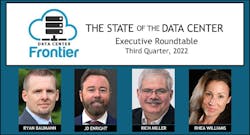Executive Roundtable: Hyperscale Data Center Demand Likely to Continue
Cloud platforms and social media networks are the largest customers in the data center business. The growth of these “hyperscale” customers has been the driving force in a global building boom for digital infrastructure. Can this incredible hyperscale investment in data centers continue?
That’s our subject as we kick off our quarterly Data Center Frontier Executive Roundtable, which features the insights of three thought leaders on the state of the data center industry. Hyperscale demand is just one of the topics we’ll examine this week in the Our Third Quarter 2022 roundtable will also explore several other relevant topics: how water scarcity will impact design, the growth prospects for second-tier markets, and the best strategies for adapting to power constraints in a growing number of major markets.
Here’s a look at our distinguished panel.
- John-David Enright, President, CEO and Chairman of HPC cooling specialist TMGcore.
- Rhea Williams, Principal Site Selection at Oracle Cloud Infrastructure and thought leader for IM Women and Infrastructure Masons.
- Ryan Baumann, Global Director of Sales for Kohler Power Systems.
Each day this week I’ll moderate a Q&A with these executives on one of our key topics. We begin with our panel’s take on the state of hyperscale computing.
Data Center Frontier: We’ve seen extraordinary demand for data center space thus far in 2022. What is driving the elevated demand for data center capacity?
RYAN BAUMANN, Kohler Power Systems
Ryan Baumann, Kohler Power Systems: There are many factors pointing at the elevated demand for data center capacity. The onset of the COVID pandemic dramatically changed the way we work, in many ways for the better. Initially, out of necessity, we transformed the traditional workplace environment from common office spaces and in-person collaboration to home offices with online meetings. These new digital workloads have become commonplace, and are driving the need for continual growth within the data center sector.
Not only is the traditional office environment changing, but the industrial environment is evolving too. Equipment and facilities in sectors like manufacturing, refining, and agriculture are all finding new ways to boost efficiency through technologies that collect new data points and advance automation. This has spread the demand of data and transmission to new locations and markets.
Additionally, we are seeing data usage and creation in younger and younger consumers. Both the youngest and oldest in our homes are connected and generating data at astounding rates. This is absolutely the new normal, and certainly not an uptick. This technological renaissance will continue to drive growth in the data center sector as we continue to digitize and decentralize the workplace. It is exciting to be a part of, and to imagine where the data will take us in the future is truly exciting.
JD ENRIGHT, TMGcore
John-David Enright, TMGcore: Innovation and integration in/of technology is, in my opinion, the primary driver for this growth. The exponential integration of AI, data analytics and other HPC applications into markets segments such as healthcare, eCommerce, national security and defense, travel and entertainment, etc. is a major factor for this. Additionally, there is still a lot of growth potential in DeFi (decentralized finance via blockchains) yet to be realized, which will add to this growth in the decade to come.
Is this a ‘new normal’ or a temporary uptick? I liken this growth to that of Moore’s Law. As long as the speed of innovation can be matched and supported by the required infrastructure, and consumer demand, we will continue this type of growth curve. That said, these things need to pace for the growth to continue and hence establish a “New Norm.” There are several other factors that contribute to this, however, these I have referenced may be the most significant.
RHEA WILLIAMS, Oracle and Infrastructure Masons.
Rhea Williams, Oracle and Infrastructure Masons: The competition between CSPs (cloud service providers) and the scarcity of power is driving users to look past the current fiscal year and into the next 60 months or beyond to ensure capacity. The mass movement of the enterprise to the cloud will continue.
I don’t see this as temporary. Our demand signal has grown exponentially and has no sign of slowing.
NEXT: How should the data center industry respond to water scarcity?
Keep pace with the fact-moving world of data centers and cloud computing by following us on Twitter and Facebook, connecting with DCF on LinkedIn, and signing up for our weekly newspaper using the form below:









